An overview of emerging technologies for 5G: Full-Duplex relaying cognitive radio networks, device-to-device communications and cell-free massive MIMO
The fifth generation (5G) cellular network has been commercialized recently to
fulfill the new demands such as very high data exchange rate, extra low latency
and high reliability. Many new technologies have been introduced and exploited
since the early of the 2010s. Among these emerging technologies, full-duplex
relaying cognitive radio networks, device-to-device communications and cell-free
massive multiple-input and multiple-output have been considered as promising
technologies/systems for 5G and beyond. This work provides a comprehensive
study on the concepts, advantages and challenges of the above-mentioned
technologies. In addition, we also introduce four new research directions which
are challenges of 5G and beyond.
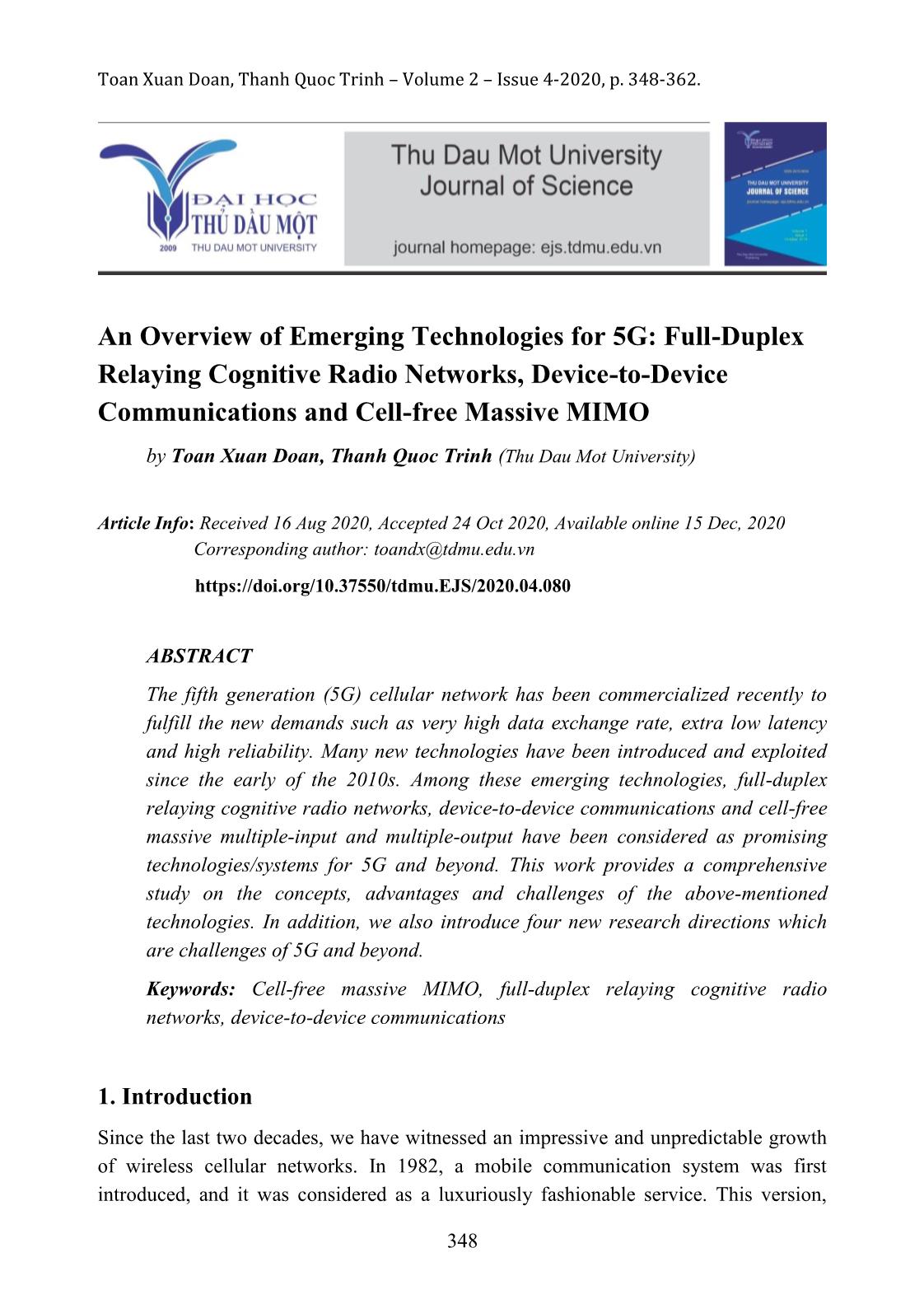
Trang 1
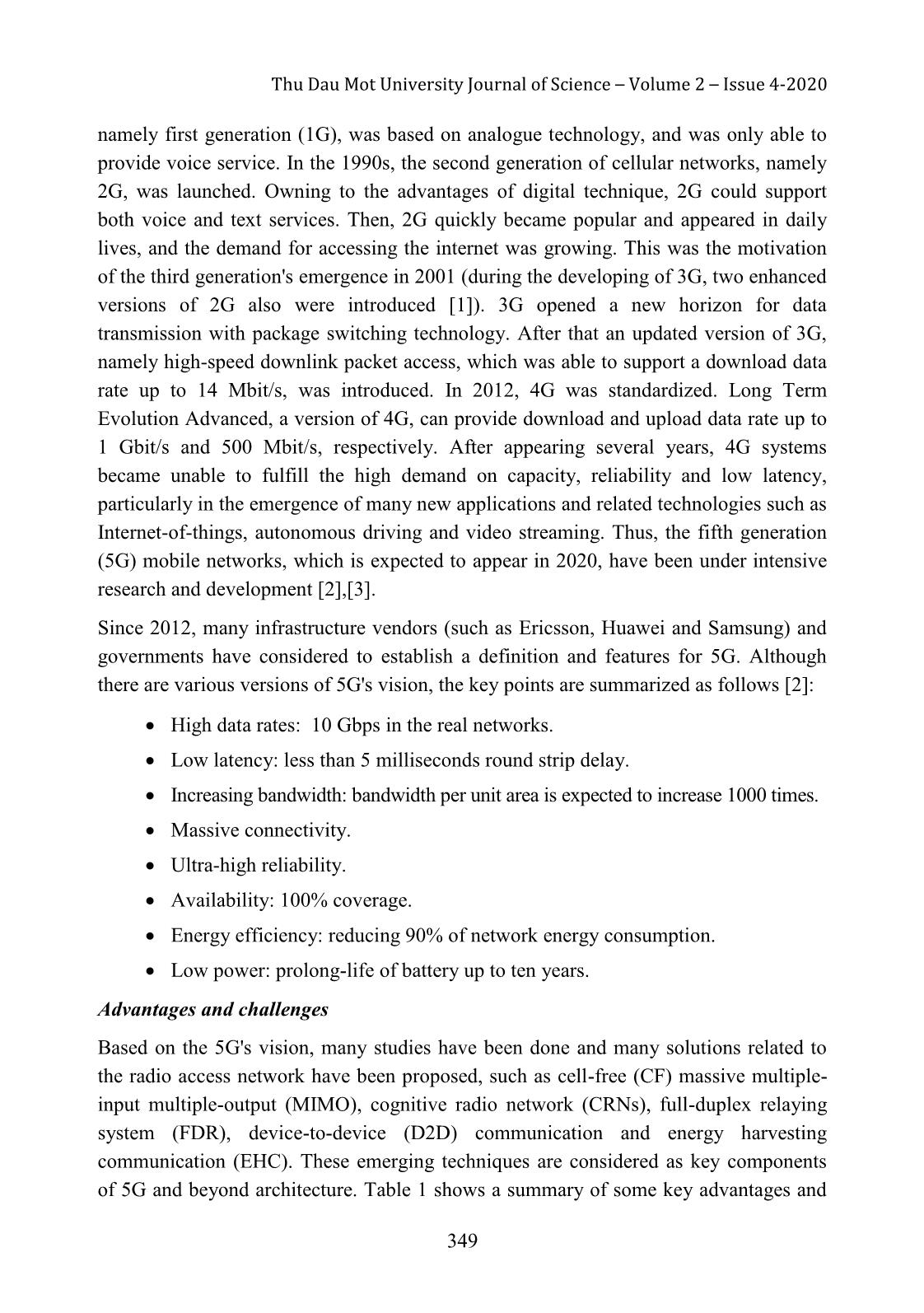
Trang 2
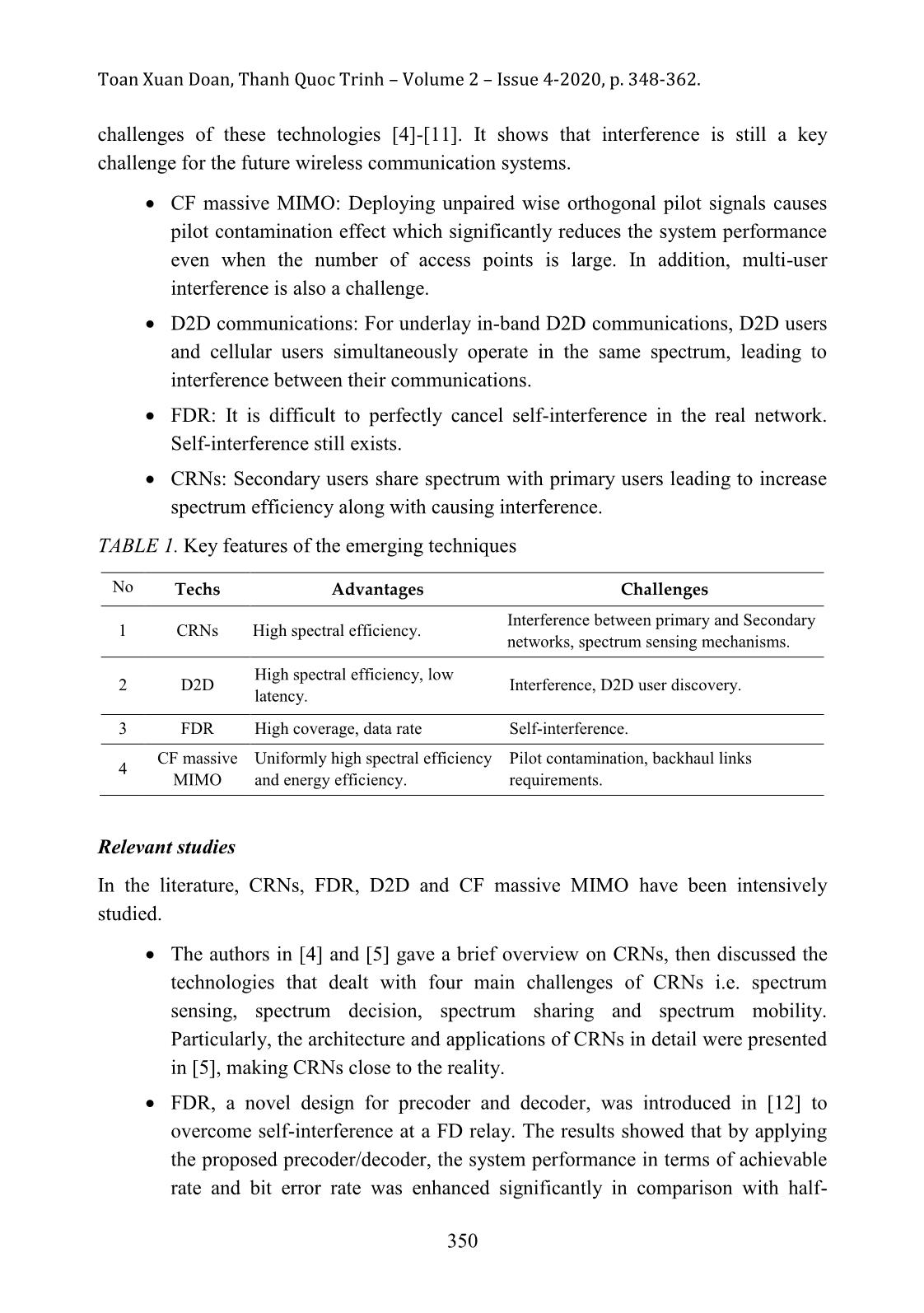
Trang 3
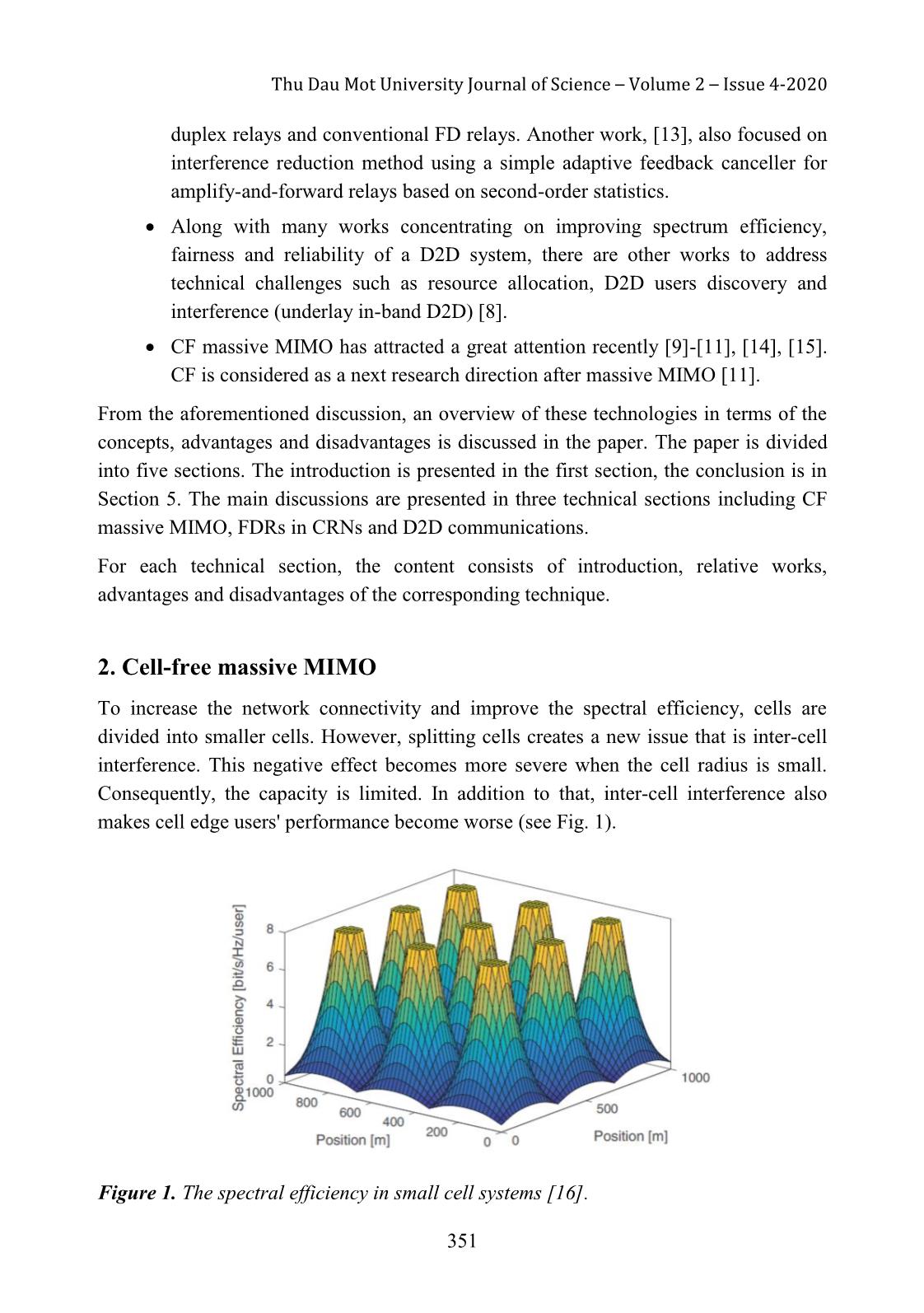
Trang 4
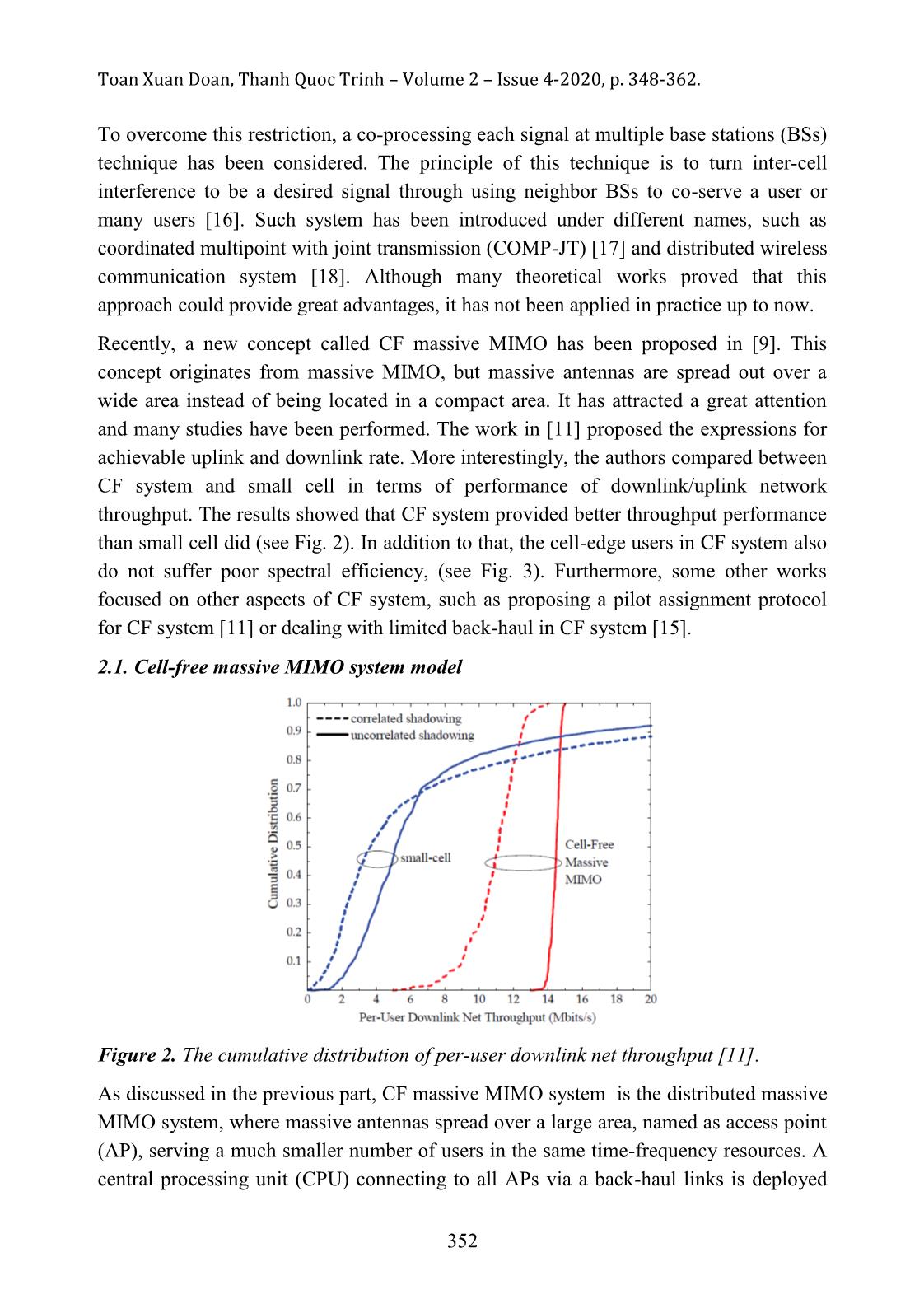
Trang 5
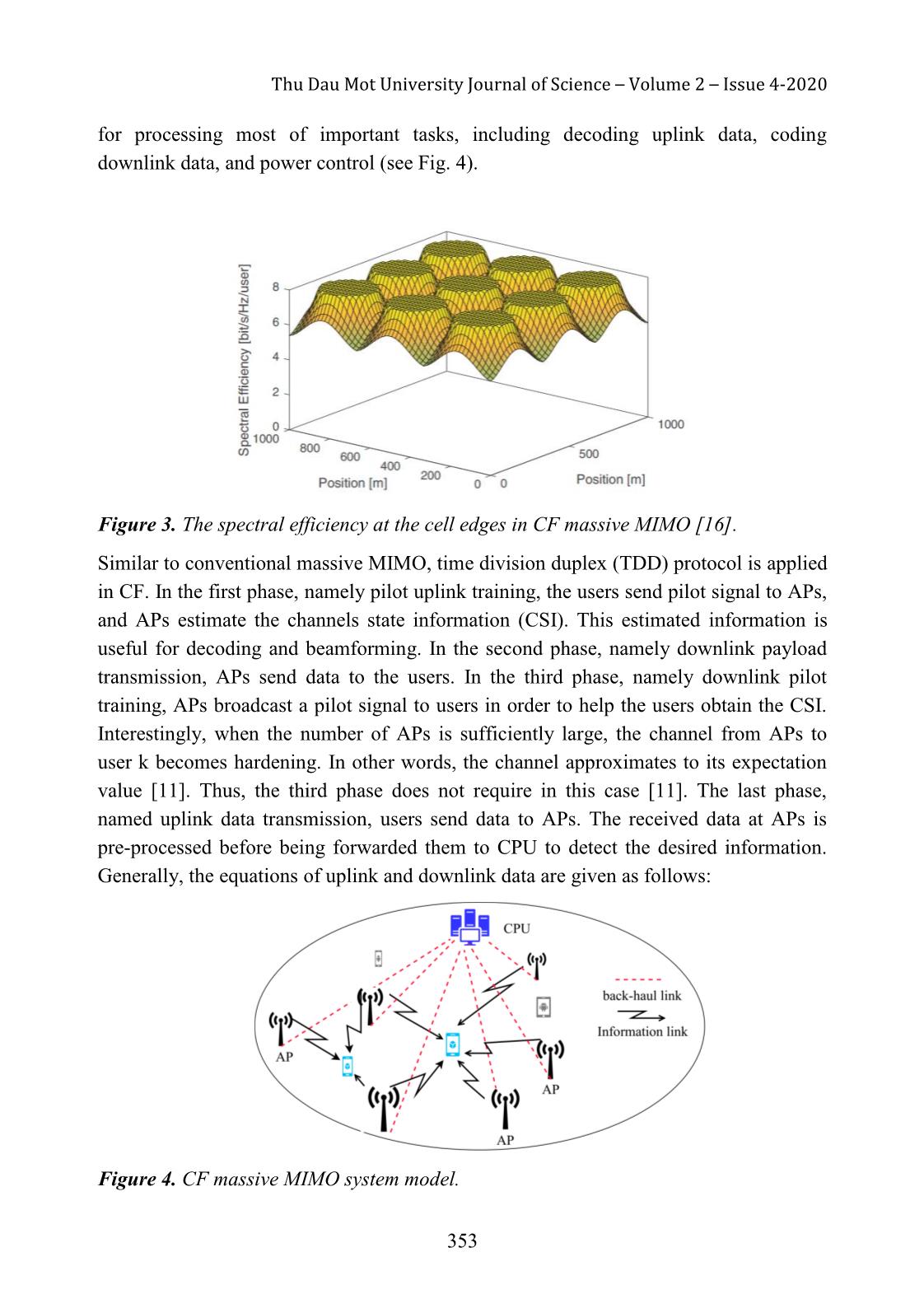
Trang 6
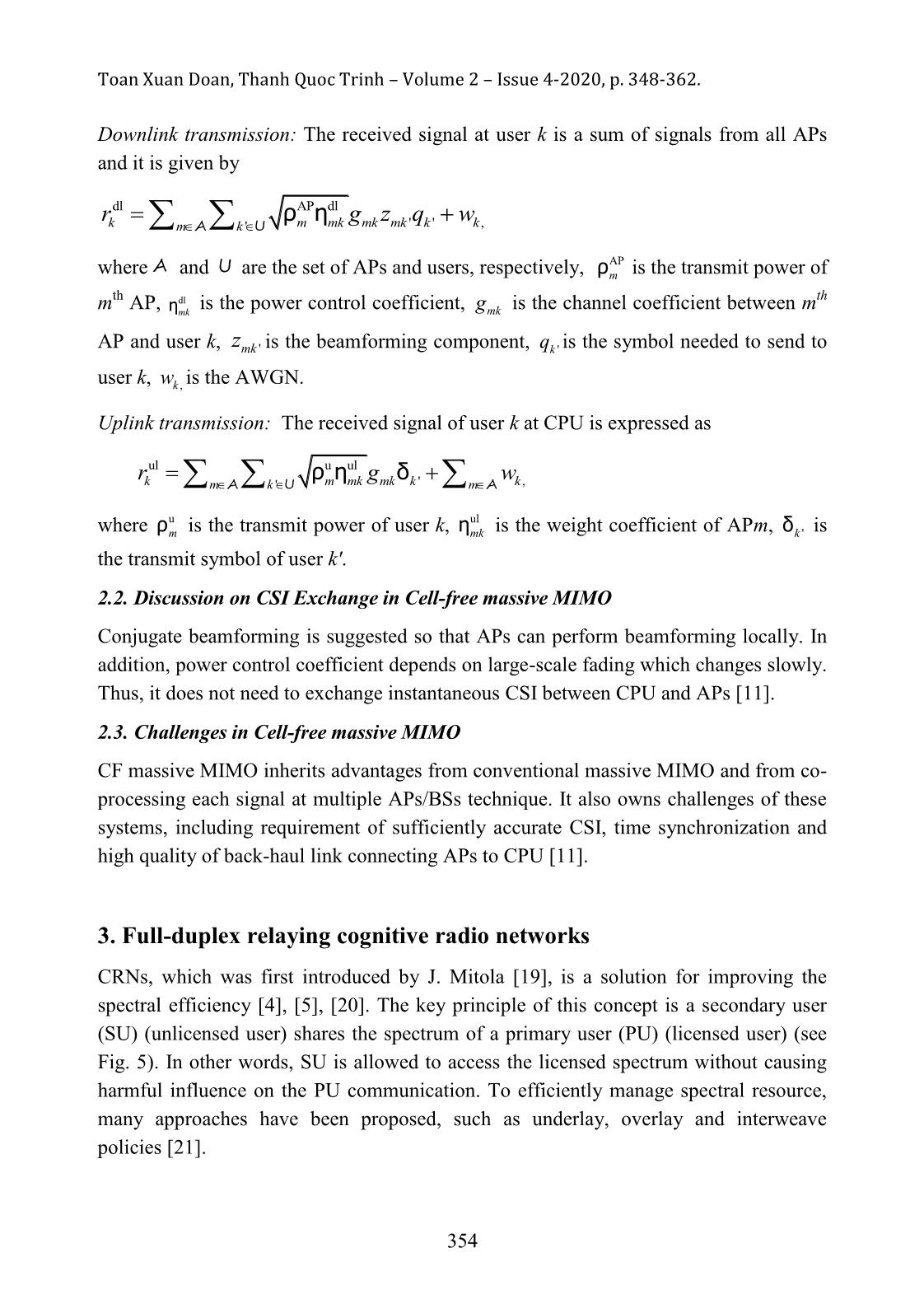
Trang 7
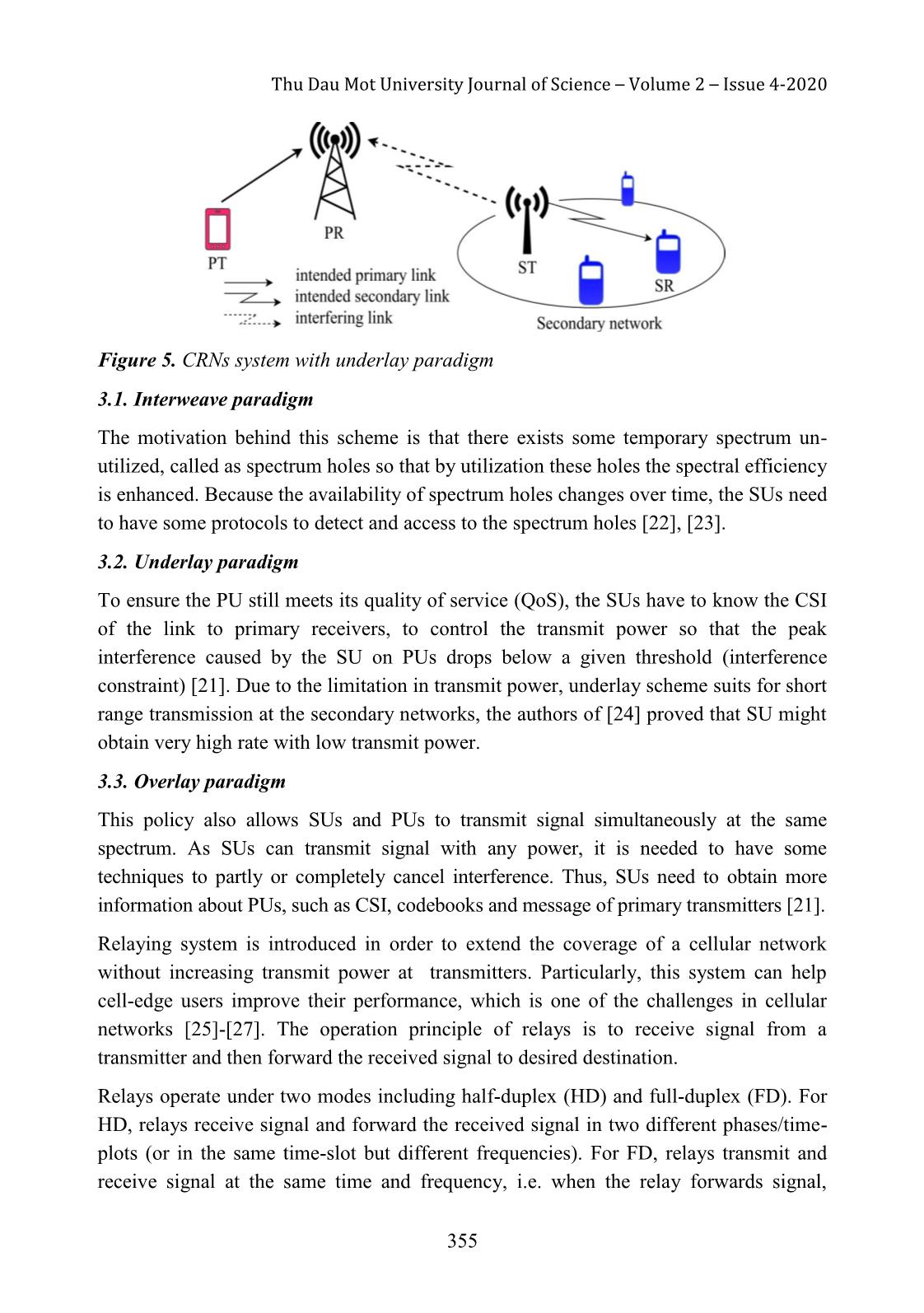
Trang 8
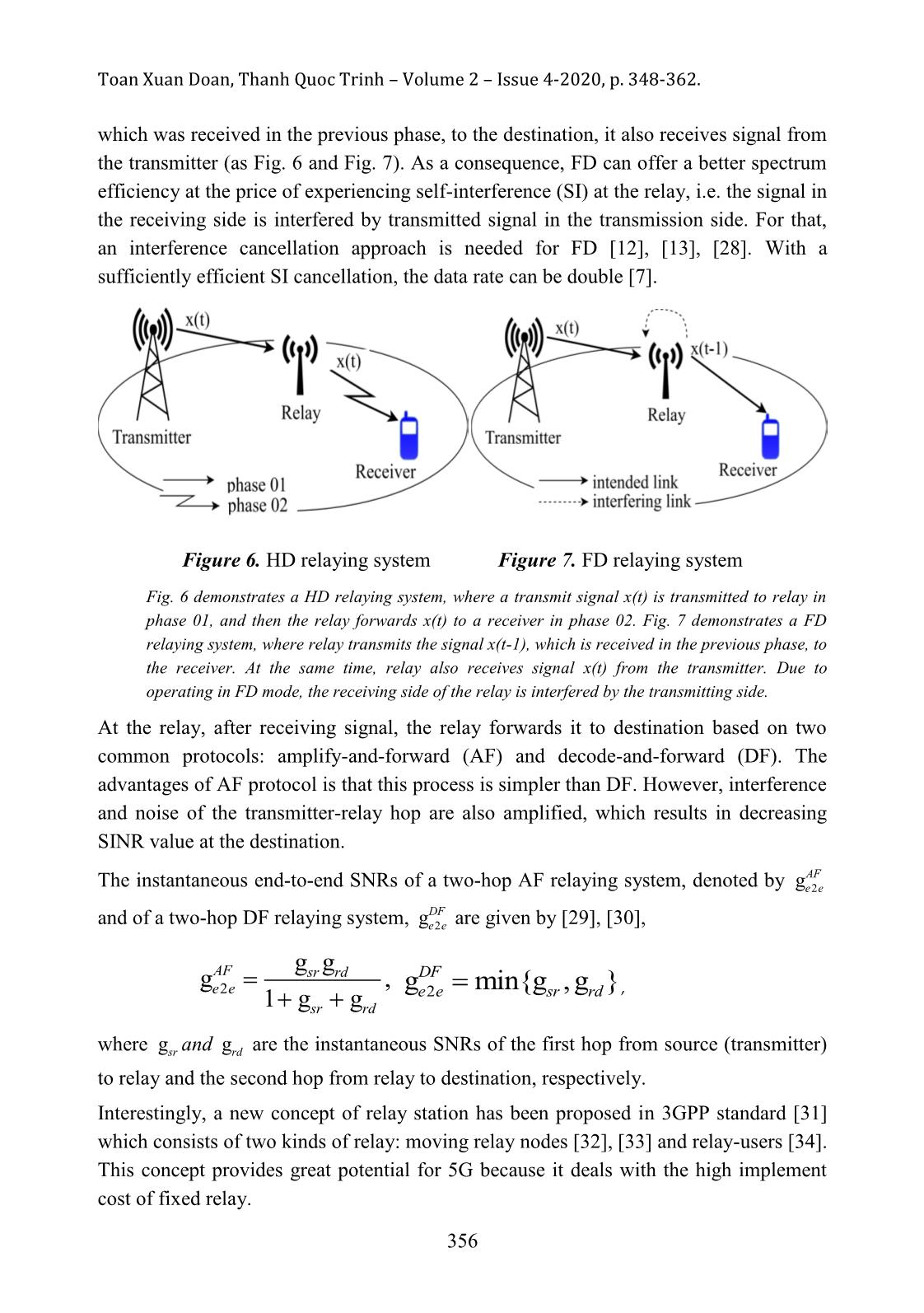
Trang 9
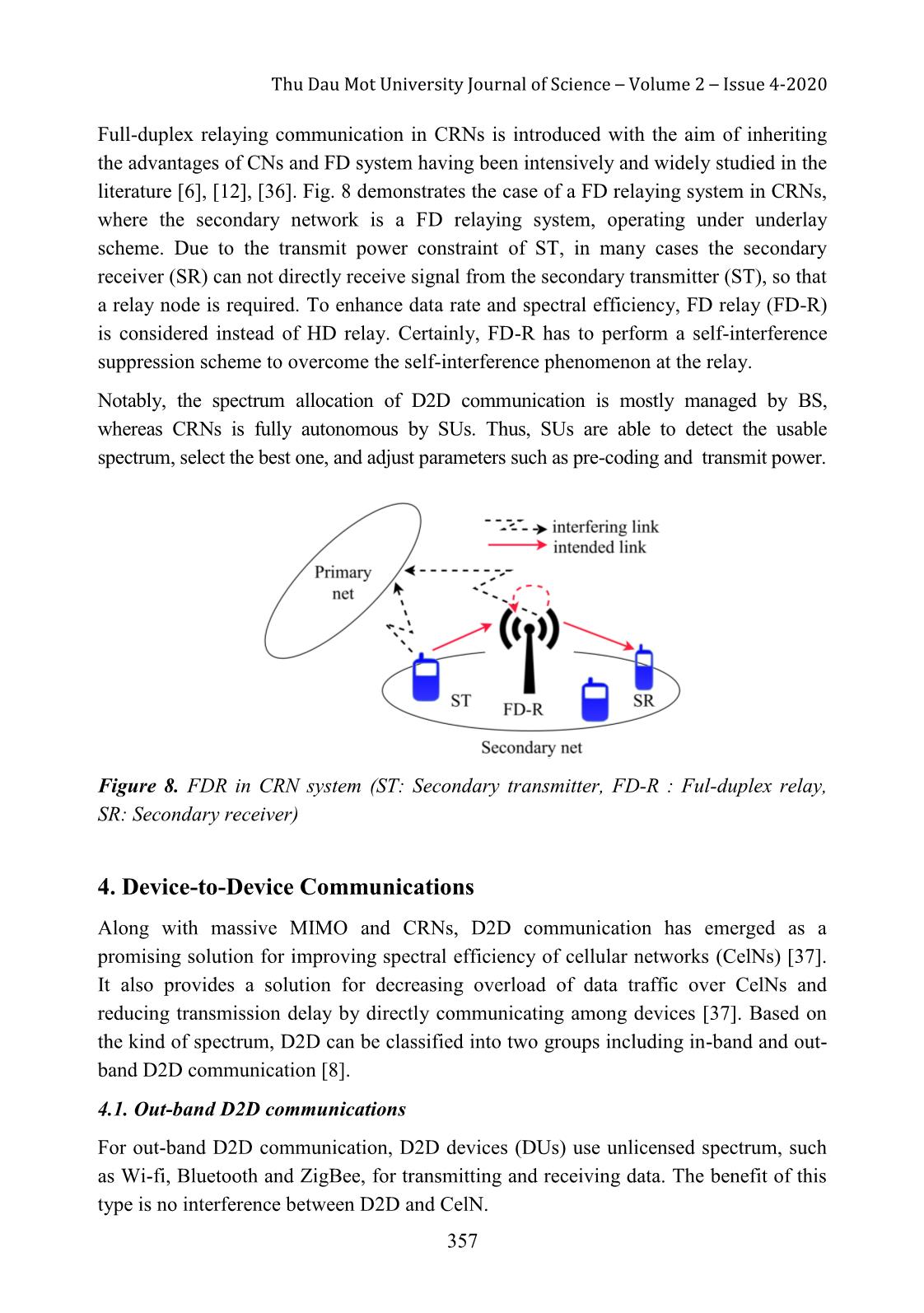
Trang 10
Tải về để xem bản đầy đủ
Tóm tắt nội dung tài liệu: An overview of emerging technologies for 5G: Full-Duplex relaying cognitive radio networks, device-to-device communications and cell-free massive MIMO

received in the previous phase, to
the receiver. At the same time, relay also receives signal x(t) from the transmitter. Due to
operating in FD mode, the receiving side of the relay is interfered by the transmitting side.
At the relay, after receiving signal, the relay forwards it to destination based on two
common protocols: amplify-and-forward (AF) and decode-and-forward (DF). The
advantages of AF protocol is that this process is simpler than DF. However, interference
and noise of the transmitter-relay hop are also amplified, which results in decreasing
SINR value at the destination.
AF
The instantaneous end-to-end SNRs of a two-hop AF relaying system, denoted by gee2
DF
and of a two-hop DF relaying system, gee2 are given by [29], [30],
AF ggsr rd DF
gee2 , ge2 e min{ g sr ,g rd },
1 ggsr rd
where gsr and grd are the instantaneous SNRs of the first hop from source (transmitter)
to relay and the second hop from relay to destination, respectively.
Interestingly, a new concept of relay station has been proposed in 3GPP standard [31]
which consists of two kinds of relay: moving relay nodes [32], [33] and relay-users [34].
This concept provides great potential for 5G because it deals with the high implement
cost of fixed relay.
356
Thu Dau Mot University Journal of Science – Volume 2 – Issue 4-2020
Full-duplex relaying communication in CRNs is introduced with the aim of inheriting
the advantages of CNs and FD system having been intensively and widely studied in the
literature [6], [12], [36]. Fig. 8 demonstrates the case of a FD relaying system in CRNs,
where the secondary network is a FD relaying system, operating under underlay
scheme. Due to the transmit power constraint of ST, in many cases the secondary
receiver (SR) can not directly receive signal from the secondary transmitter (ST), so that
a relay node is required. To enhance data rate and spectral efficiency, FD relay (FD-R)
is considered instead of HD relay. Certainly, FD-R has to perform a self-interference
suppression scheme to overcome the self-interference phenomenon at the relay.
Notably, the spectrum allocation of D2D communication is mostly managed by BS,
whereas CRNs is fully autonomous by SUs. Thus, SUs are able to detect the usable
spectrum, select the best one, and adjust parameters such as pre-coding and transmit power.
Figure 8. FDR in CRN system (ST: Secondary transmitter, FD-R : Ful-duplex relay,
SR: Secondary receiver)
4. Device-to-Device Communications
Along with massive MIMO and CRNs, D2D communication has emerged as a
promising solution for improving spectral efficiency of cellular networks (CelNs) [37].
It also provides a solution for decreasing overload of data traffic over CelNs and
reducing transmission delay by directly communicating among devices [37]. Based on
the kind of spectrum, D2D can be classified into two groups including in-band and out-
band D2D communication [8].
4.1. Out-band D2D communications
For out-band D2D communication, D2D devices (DUs) use unlicensed spectrum, such
as Wi-fi, Bluetooth and ZigBee, for transmitting and receiving data. The benefit of this
type is no interference between D2D and CelN.
357
Toan Xuan Doan, Thanh Quoc Trinh – Volume 2 – Issue 4-2020, p. 348-362.
In terms of spectrum access policies, a device can occupy an unlicensed spectrum under the
management of CelNs, called controlled out-band communication, or without any
involvement of CelNs, called autonomous out-band communication [8]. For the former, the
D2D communication performance can be controlled to improve the reliability and to ensure
QoS. In contrast, autonomous out-band communication independently operates from CelN,
which means that less overhead of CelNs, but the QoS cannot be controlled [38].
4.2. In-band D2D communications
Different from out-band, DUs share spectrum with cellular users (CelUs) in two modes:
underlay mode (UMod) and overlay mode (OMod) [8]. The advantage of this paradigm
is that CelNs are able to manage performance of D2D communications.
For OMod, the radio and time resources are allocated to DUs and CelUs such that there
is no interference caused by D2D communication on CelNs and vice versa. As a result,
interference management is not needed for this case, but the spectrum efficiency is not
optimal and CelUs cannot exploit the full capacity of CelNs that can provide [8].
For UMod, both DUs and CelUs can use the same frequency and the same time slot for
their transmissions, resulting in existing interference among them. Thus, the system
needs to implement an additional scheme to partly or totally cancel the interference,
making the system more complicated. With a sufficiently good interference
management, the spectrum efficiency of this mode is improved significantly [38].
TABLE 2. Some key features of in-band and out-band D2D communications
Advantages In-band Out-band
underlay overlay control auto
Enable to control the performance of DUs Y Y Y N
Improve spectral efficiency Y Y N N
CelNs’ spectral efficiency is optimal Y N NA NA
Enable DUs and simultaneously operate on the same
Y N NA NA
spectrum of CelNs
Along with EE, reducing energy consumption and prolonging battery life are also two
important aspects in 5G visions [2]. Among many solutions, wireless power transfer
(WPT) and energy harvesting (EH) have drawn great attention from the research
community. The main concept of EH is to harvest and convert unused energy to useful
energy to charge batteries. For natural energies such as solar and wind, they are free but
strongly depend on weather and unable to exactly predict, meanwhile wireless
communication systems require high reliability. For that reason, radio frequency (RF)
358
Thu Dau Mot University Journal of Science – Volume 2 – Issue 4-2020
signals, which are independent of natural conditions, become a potential resource
[39],[40]. For WPT, energy is wirelessly transmitted to an intended receiver and it is
usually fully controlled by transmitters.
Although EH and WPT have been considered as a promising technique, there still are
some challenges that need to be solved to make it practical. For example, the amount of
harvested energy is very small. Thus, the application of EH and WPT, recently, has
been considered in D2D communications due to low-power devices and short
transmission.
Figure 9. An example of EH based D2D communication system.
5. Conclusions
Throughout the paper, we have presented a comprehensive study on the emerging
techniques for 5G including FDR in CRNs, D2D communications and CF massive
MIMO. Some potential directions could be developed from the paper are listed as
follows:
Due to the randomness of location of users in CF massive MIMO, deploying
stochastic geometry theory to model the system is an potential topic.
Resource allocation for multigroup multicast CF massive MIMO to reduce the
inter-user interference.
In the near future, the need of directly communicating between devices is
predicted to increase. Thus, considering D2D system in CF massive MIMO is
also a promising direction.
The development of low power devices makes energy harvesting become
more practical. However, EHC in CF massive MIMO has not been studied in
the literature.
359
Toan Xuan Doan, Thanh Quoc Trinh – Volume 2 – Issue 4-2020, p. 348-362.
References
[1] D. Molkdar, W. Featherstone, S. Lambotharan (2002). An overview of EGPRS: the packet
data component of EDGE. J. Electron. Commun. Eng., 14(1),21–38.
[2] GSMA Intelligence (2014). Understanding 5G: Perspectives on future technological
advancements in mobile. White paper.
[3] M. Agiwal and A. Roy and N. Saxena (2016). Next Generation 5G Wireless Networks: A
Comprehensive Survey. IEEE Commun. Surveys Tuts., 18(3), 1617–1655.
[4] F. Akyildiz and W. y. Lee and M. C. Vuran and S. Mohanty (2008). A survey on spectrum
management in cognitive radio networks. IEEE Commun. Mag., 46(4), 40–48.
[5] B. Wang and K. J. R. Liu (2011). Advances in cognitive radio networks: A survey. IEEE J.
Sel. Topics Signal Process, 5(1), 5–23.
[6] M. Amjad and F. Akhtar and M. H. Rehmani and M. Reisslein and T. Umer (2017). Full-
Duplex Communication in Cognitive Radio Networks: A Survey. IEEE Commun. Surveys
Tuts, 19(4), 2158–2191.
[7] Z. Zhang and K. Long and A. V. Vasilakos and L. Hanzo (2016). Full-Duplex Wireless
Communications: Challenges, Solutions, and Future Research Directions. Proc. of the
IEEE, 104(7), 1369–1409.
[8] Asadi and Q. Wang and V. Mancuso (2014). A Survey on Device-toDevice
Communication in Cellular Networks. IEEE Commun. Surveys Tuts., 16(4), 1801–1819.
[9] H. Q. Ngo and A. Ashikhmin and H. Yang and E. G. Larsson and T. L. Marzetta (2015).
Cell-Free Massive MIMO: Uniformly great service for everyone. in Proc. Int. Workshop
Signal Process. Adv. Wireless Commun., pp. 201–205.
[10] H. Q. Ngo and L. N. Tran and T. Q. Duong and M. Matthaiou and E. G. Larsson (2018).
On the Total Energy Efficiency of Cell-Free Massive MIMO. IEEE Trans. Green
Commun. Netw, 2(1), 25–39.
[11] H. Q. Ngo and A. Ashikhmin and H. Yang and E. G. Larsson and T. L. Marzetta (2017).
Cell-Free Massive MIMO Versus Small Cells. IEEE Trans. Wireless Commun, 16(3),
1834–1850.
[12] H. Ju and E. Oh and D. Hong (2009). Improving efficiency of resource usage in two-hop
full duplex relay systems based on resource sharing and interference cancellation. IEEE
Trans. Wireless Commun., 8(8), 3933–3938.
[13] R. Lopez-Valcarce and E. Antonio-Rodriguez and C. Mosquera and F. Perez-Gonzalez
(2012). An Adaptive Feedback Canceller for Full-Duplex Relays Based on Spectrum
Shaping. IEEE J. Sel. Areas Commun, 30(8), 1566–1577.
[14] G. Interdonato and H. Q. Ngo and E. G. Larsson and P. Frenger (2016). How Much Do
Downlink Pilots Improve Cell-Free Massive MIMO? IEEE Global Communications
Conference (GLOBECOM), p.1–7.
[15] M. Bashar, K. Cumanan, A. G. Burr, H. Q. Ngo, and M. Debbah (2018). Cell-free
Massive MIMO with limited backhaul, in Proc. IEEE ICC, pp. 1–7.
360
Thu Dau Mot University Journal of Science – Volume 2 – Issue 4-2020
[16] S. Shamai and B. M. Zaidel (2001). Enhancing the cellular downlink capacity via co-
processing at the transmitting end. in Proc. IEEE VTC-Spring, vol. 3, pp. 1745–1749.
[17] Osseiran, J. F. Monserrat, and P. Marsch (2016). 5G Mobile and Wireless Communications
Technology. Cambridge University Press, ch. 9, Coordinated Multi-Point Transmission in
5G.
[18] Shidong Zhou and Ming Zhao and Xibin Xu and Jing Wang and Yan Yao (2003).
Distributed wireless communication system: a new architecture for future public wireless
access. IEEE Commun. Mag., 41(3), 108–113.
[19] J. Mitola and G. Q. Maguire (1999). Cognitive radio: making software radios more
personal. IEEE Pers. Commun., 6(4), 13–18.
[20] G. I. Tsiropoulos and O. A. Dobre and M. H. Ahmed and K. E. Baddour (2016). Radio
Resource Allocation Techniques for Efficient Spectrum Access in Cognitive Radio
Networks. IEEE Commun. Surv. Tutor, 18(1), 824–847.
[21] Goldsmith and S. A. Jafar and I. Maric and S. Srinivasa (2009). Breaking Spectrum
Gridlock With Cognitive Radios: An Information Theoretic Perspective. Proc. IEEE,
97(5), 894–914.
[22] V. Valenta and R. Marsˇalek and G. Baudoin and M. Villegas ´ and M. Suarez and F.
Robert (2010). Survey on spectrum utilization in Europe: Measurements, analyses and
observations. in Proc. 5th Int. Conf. CrownCom, Jun. 2010.
[23] S. Haykin (2005). Cognitive radio: brain-empowered wireless communications. IEEE J.
Sel. Areas Commun., 23(2), 201–220.
[24] S. Srinivasa and S. A. Jafar (2007). Cognitive Radios for Dynamic Spectrum Access - The
Throughput Potential of Cognitive Radio: A Theoretical Perspective. IEEE Commun.
Mag., 45(5), 73–79.
[25] M. O. Hasna and M. S. Alouini (2003). End-to-end performance of transmission systems
with relays over Rayleigh-fading channels. IEEE Trans. Wireless Commun., 2(6), 1126–
113.
[26] S. Ikki and M. H. Ahmed (2007). Performance Analysis of Cooperative Diversity Wireless
Networks over Nakagami-m Fading Channel. IEEE Commun. Lett., 11(4),334–336.
[27] H. A. Suraweera and H. K. Garg and A. Nallanathan, “Performance Analysis of Two Hop
Amplify-and-Forward Systems with Interference at the Relay,” IEEE Commun. Lett., vol.
14, no. 8, pp. 692–694, Aug. 2010.
[28] J. H. Lee and O. S. Shin (2010). Full-duplex relay based on block diagonalisation in
multiple-input multiple-output relay systems. IET Comm., 4(15), 1817–1826.
[29] J. N. Laneman and D. N. C. Tse and G. W. Wornell (2004). Cooperative diversity in
wireless networks: Efficient protocols and outage behavior. IEEE Trans. Inf. Theory,
50(12), 3062–3080.
[30] T. Q. Duong and Vo Nguyen Quoc Bao and H. j. Zepernick (2009). On the performance of
selection decode-and-forward relay networks over Nakagami-m fading channels. IEEE
Commun. Lett., 13(3), 172–174.
361
Toan Xuan Doan, Thanh Quoc Trinh – Volume 2 – Issue 4-2020, p. 348-362.
[31] S. Yang and X. Xu and D. Alanis and S. Xin Ng and L. Hanzo (2016). Is the Low-
Complexity Mobile-Relay-Aided FFR-DAS Capable of Outperforming the High-
Complexity CoMP?. IEEE Trans. Veh. Technol., 65(4), 2154–2169.
[32] M. S. Pan and T. M. Lin and W. T. Chen (2015). An Enhanced Handover Scheme for
Mobile Relays in LTE-A High-Speed Rail Networks. IEEE Trans. Veh. Technol., 64(2),
743–75.
[33] D. Hwang and D. I. Kim and S. K. Choi and T. J. Lee (2015). UE Relaying Cooperation
Over D2D Uplink in Heterogeneous Cellular Networks. IEEE Trans. Commun., 63(12),
4784–4796.
[34] S. S. Nam and M. S. Alouini and S. Choi (2018). Iterative Relay Scheduling With Hybrid
ARQ Under Multiple User Equipment (Type II) Relay Environments. IEEE Access, vol. 6,
pp. 6455–6463.
[35] M. G. Khafagy, M. S. Alouini, and S. A¨ıssa (2018). Full-duplex relay selection in
cognitive underlay networks. IEEE Trans. Commun., pp. 1–1.
[36] D. Feng and L. Lu and Y. Yuan-Wu and G. Y. Li and S. Li and G. Feng (2014). Device-to-
device communications in cellular networks. IEEE Commun. Mag., 52(4), 49–5.
[37] F. Jameel and Z. Hamid and F. Jabeen and S. Zeadally and M. A.Javed (2018). A Survey
of Device-to-Device Communications: Research Issues and Challenges. IEEE Commun.
Surveys Tuts., pp. 1–1,.
[38] S. Sudevalayam and P. Kulkarni (2011). Energy Harvesting Sensor Nodes: Survey and
Implications. IEEE Commun. Surveys Tuts., 13(3), 443–461.
[39] R. V. Prasad and S. Devasenapathy and V. S. Rao and J. Vazifehdan (2014). Reincarnation
in the Ambiance: Devices and Networks with Energy Harvesting. IEEE Commun. Surveys
Tuts., 16(1), 195–213.
362 File đính kèm:
 an_overview_of_emerging_technologies_for_5g_full_duplex_rela.pdf
an_overview_of_emerging_technologies_for_5g_full_duplex_rela.pdf

